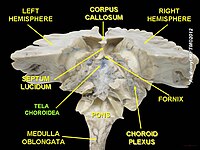
Photo from wikipedia
INTRODUCTION The incidence of grade 3-4 perineal tears, also known as obstetric anal sphincter injury (OASI), is reported to be between 0.5 and 2.5%. Beyond the medico-economic burden, the consequences… Click to show full abstract
INTRODUCTION The incidence of grade 3-4 perineal tears, also known as obstetric anal sphincter injury (OASI), is reported to be between 0.5 and 2.5%. Beyond the medico-economic burden, the consequences of OASI on a woman's emotional, psychological, sexual, and physical wellbeing are considerable. Among the various risk factors of OASI, few data are available about the impact of a language barrier on its incidence. MATERIAL AND METHODS We conducted a case-control study to evaluate the effect of language barriers on the risk of OASI comparing 171 women with OASI and 163 matched controls. The matched criteria included ethnicity, age, previous vaginal delivery, delivery mode, prophylactic episiotomy and birthweight. Patients' characteristics were compared and crude ORs and 95% CIs estimated using unadjusted logistic models. Multivariate analysis was performed with recognized potential confounders. RESULTS All of the cases had grade 3 tears. Language barrier was a determinant factor of OASI with an OR of 3.32 [1.36-8.90], p=0.01. Other risk factors were occipito-posterior delivery, African origin and prolonged labor duration (OR 6.33, 95% CI: 2.04-27.78, p=0.004, OR 1.85, 95% CI: 1.08-3.19, p=0.03 and OR 1.03, 95% CI: 1.01-1.05, p=0.004, respectively). CONCLUSION Our data suggest that language barrier is an independent risk factor of OASI. Physicians and midwives should attempt to identify patients with a language barrier during prenatal visits. Education about simple terms used during delivery could decrease the incidence of this complication.
Journal Title: Journal of gynecology obstetrics and human reproduction
Year Published: 2021
Link to full text (if available)
Share on Social Media: Sign Up to like & get
recommendations!